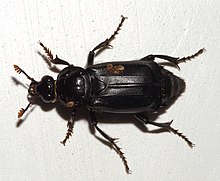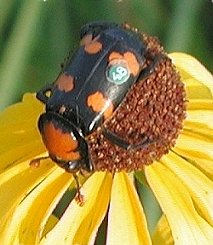Gravedigger (beetle)
| mortician undertaker | ||||||||||||
|---|---|---|---|---|---|---|---|---|---|---|---|---|

Black-horned gravedigger ( Nicrophorus vespilloides ) |
||||||||||||
| Systematics | ||||||||||||
|
||||||||||||
| Scientific name | ||||||||||||
| Nicrophorus | ||||||||||||
| Fabricius , 1775 |
The gravedigger of the genus Nicrophorus , also known as Necrophorus according to the nomenclature that has since become invalid , are among the best-known users of the carrion of smaller animals. These are beetles (Coleoptera) of the carrion beetle family (Silphidae).
Reproduction and Development of the Gravedigger
They mainly use the carrion to care for their brood. Nicrophorus species are predatory and live mainly on flies and mosquito larvae , but the largest native species ( Nicrophorus germanicus ) also hunts larger beetles, including the well-known dung beetle ( Geotrupes spec. ). In addition to the predatory diet, the adults also eat fresh carrion.
Most grave diggers, such as N. vespilloides , N. vespillo and N. humator, begin to reproduce in May, but N. investigator does not begin until August. Both sexes of the animals are attracted by the carrion odor of small animal corpses and accordingly find themselves there together. Males arriving first immediately begin to bury the carcass on the surface. After that, they begin a behavior known as "starling". The abdomen is stretched upwards and moved up and down, while the normally concealed last abdominal segment is shown. These starving males are just as attractive to conspecifics as the carrion itself. If several beetles arrive at the carcass at the same time, fights ensue, in which the inferior beetle leaves the field. However, arriving females are welcome.
Together, the gravedigger couple undermines the carcass so that it sinks in. Then a sloping passage is laid in the ground and the carcass is pulled behind. As a result of this squeezing into the passage and the constant pulling of the beetles, the corpse becomes more and more rounded. Nicrophorus humator buries the animal up to seven centimeters deep, with Nicrophorus vespilloides it is only loosely brought under the leaves. The eggs are laid in one or more passages in the earth, never directly on the carrion. Then the female eats a hole in the carrion ball and marks the carrion with liquid excrement.
The hatched beetle larvae collect in the hole created by the mother in the carcass and enlarge it. Only after the second molt do the larvae eat their way into the interior of the ball. Especially after the first molt , the larvae are fed by their mother because their mouthparts are still soft and are unable to take in food themselves. Towards the end of larval development, the larvae leave the carrion and distribute themselves within a radius of about 30 centimeters around the brood cavity to pupate . This is initiated by the construction of the doll's cradle, which is created by rotating the larva around its own axis for hours. The species that begin to reproduce early in the year end their development in the same year and overwinter as adults. Late-reproducing species overwinter as pupae and complete their development in the following year. In all species, it takes around 14 days to reach sexual maturity after the adults have hatched.
Types of gravedigger

There are around 70 species of the genus worldwide that are distributed across Eurasia and North America.
The following nine species are known in Europe:
- Nicrophorus antennatus
- Black gravedigger ( Nicrophorus humator )
- Nicrophorus interruptus
- Nicrophorus investigator
- Nicrophorus germanicus
- Nicrophorus sepultor
- Common gravedigger ( Nicrophorus vespillo )
- Black-horned gravedigger ( Nicrophorus vespilloides )
- Nicrophorus vestigator
The common gravedigger ( Nicrophorus vespillo ) is the only species found in both North America and Eurasia. These species also occur in North America:
- Nicrophorus americanus
- Nicrophorus sayi
- Nicrophorus orbicollis
- Nicrophorus pustulatus
- Nicrophorus defodiens
- Nicrophorus tomentosus
- Nicrophorus marginatus
- Nicrophorus vespillum
Web links
- Investigation of the carrion-dwelling beetle fauna in Erlangen (PDF; 13.86 MB) ( Memento from October 20, 2007 in the Internet Archive )
- Work on carrion beetles - Investigation of the carrion-dwelling beetle fauna in Erlangen 2006: ecology of a carcass, guilds on the carcass, succession (settlement consequences) on the carcass, dependence of the carcass fauna on weather, location and carcass type ... (PDF file; 13.86 MB)

